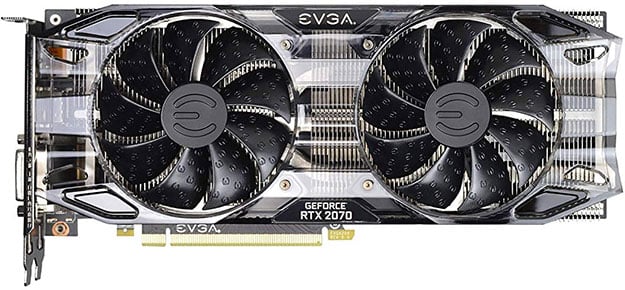EVGA is one of the few companies to release multiple
GeForce RTX series cards based on
NVIDIA's reference specs,
and at
reference price points (an important qualifier). That means you can actually buy a
GeForce RTX 2070 for $499.99, rather than pay a premium for NVIDIA's own overclocked Founders Edition model, or any of the several overclocked SKUs by NVIDIA's add-in board (AIB) partners. EVGA, for example, sells an overclocked GeForce RTX 2070 for $569.99. As it turns out, there might be more of a difference than just the out-of-the-box specs. More on that in a moment.
For anyone who has not been following the GeForce RTX launch, NVIDIA released three cards:
GeForce RTX 2080 Ti, GeForce RTX 2080, and GeForce RTX 2070. All three are available from NVIDIA as Founders Edition models, and unlike the previous generation (Pascal), the FE models come overclocked. NVIDIA also overhauled the cooling solution, trading the blower-style design for a cooler that is similar to what its AIB partners typically use.
NVIDIA also announced reference specs at lower price points, with the presumption its AIB partners would offer both reference and overclocked models. Here's how the pricing shakes out:
- GeForce RTX 2080 Ti Founders Edition: $1,199
- GeForce RTX 2080 Ti Reference: $999
- GeForce RTX 2080 Founders Edition: $799
- GeForce RTX 2080 Reference: $699
- GeForce RTX 2070 Founders Edition: $599
- GeForce RTX 2070 Reference: $499
Now here's where things get interesting. Steve Burke at
Gamers Nexus got his hands on two different GeForce RTX 2070 models from EVGA, and specifically these ones...
- EVGA GeForce RTX 2070 XC Ultra Gaming: $569.99
- EVGA GeForce RTX 2070 Black Gaming: $499.99
Burke stripped both cards to get a look at the GPU, and lo and behold, they're slightly different. The GPU underneath the hood on the Black Gaming card is a TU106-400-A1 and the GPU on the XC Ultra Gaming is a TU106-400A-A1. Both are Turing GPUs and they are essentially the same in terms of specs and features. However, it appears that the "A" revision is a binned part that is able to run faster and hold its boost clock for a longer period of time.
It's important to understand that not all chips are the same. That applies to all semiconductors, whether it's a CPU, GPU, or RAM. In essence, you could buy two of the same model processor and see very different overclocking results. This is where binning comes into play. Companies like NVIDIA have the ability to test and sort chips based on how well they handle higher voltages and higher clockspeeds.
At first glance, Burke seems to have discovered that NVIDIA is binning its Turing chips, which in turn is selling two different versions to its board partners (at least for the GeForce RTX 2070). The TU106-400A-A1 likely costs more, and so it ends up in higher priced cards with factory overclocks. Does it matter? It can, as Burke noted when running the two EVGA cards in 3DMark.
"The XC Ultra averages about 1935MHz for the entirety of the test, whereas the 2070 Black experiences clock decay from about 1815MHz down to 1785MHz. The average frequency bounces between 1785MHz and 1800MHz for the 2070 Black. This is a significant difference for out-of-the-box frequencies, and indicates that performance advantage resultant of the better binned GPUs," Burke wrote.
Running at overclocked specs versus reference clocks mostly equates to a few frames per second, depending on the game and settings. However, it's interesting that the difference between a stock-clocked card and an overclocked one isn't just the specs, but the actual GPU. Something to bear in mind when/if shopping for a GeForce RTX card.



